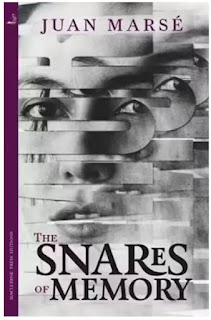Snares of Memory
Juan Marsé’s The
Snares of Memory begins with 48 numbered responses to what appears to be
written replies to interview questions posed to a writer/novelist. In this way, Marsé
introduces the idea of a writer working on a commissioned film script
concerning a murder which took place in 1949. Many of these answers contain
refutations of conventional ideas, or ethical statements (“I couldn’t give a
damn about national identity. It’s an emotional swindle”). Even better, we have
to guess at the questions being asked (the response to Question 40 is simply
“Pass”).
10) My next novel will deal with the tricks and snares
created for us by memory, that high-class whore.
11) No. If I tell you what it’s about, I’ll spoil it, because
this novel is a kind of tromp-l’oeil.
Nothing in it is what it seems, starting with the title. (p. 8).
So far, so good – Marsé had me hooked from the very
beginning.
The script, the narrator tells us early on, is based on a
true event – a prostitute, murdered in a projection booth, “strangled with a
collar of celluloid” (p. 14). The murderer confessed, but suffered subsequent
amnesia, and hence a mystery remains over the meaning and motive for the act.
The writer, and director of the film, Héctor Roldán, see a wider cultural
reflection in the story:
In those days, the summer of 1982, the whole country was torn
between memory and forgetting … he wanted the sordid story of the crime in the
Delicias cinema to be a film reflecting the moral and political turpitude of
the Franco regime, buried four years earlier when we embarked on the transition
to democracy (p. 15).
The director wants the writer to produce a script based on
reality: a “faithful chronicle of how the crime in that booth was committed”
(p. 19). The novel includes sections of the writer’s script, using basic filmic
conventions, but also the details of his investigation into the crime. Most
particularly, he meets the murderer of Carolina Bruil Latorre, a young
projectionist by the name of Fermín Sicart Nelo, now an elderly man
released from prison after serving a lengthy sentence. Details of the crime as
can be established by fact are then set against Fermín’s failed memory, stemming –
perhaps – from a brutal investigation and “treatment” by a notorious Dr
Tejero-Cámara
(as “promoted and financed by the Franco regime’s repressive apparatus” [p.
108]).
In short, there are doubts about whether Fermín
was the murderer, or the victim of jealousy by a scheming Falangist, with
reference to clandestine activities by members of the banned C.N.T.
Where we might expect or hope for a resolution in which the
truth comes out in the cinema, the writer’s script is soon commercialised in
the most ridiculous manner. Only the book remains, as a playful record of the
snares of memory – the traps of thinking that a narrative can stand for a
national tragedy, and some wrongs could be ‘righted’ in the process of
investigating corruption and murder. I’d like to read this book again, perhaps
in another year or two, because it is a rich text and its serious themes are
handled with the light touch of a writer who knows what it means to have
survived a dictatorship.




Comments
Post a Comment